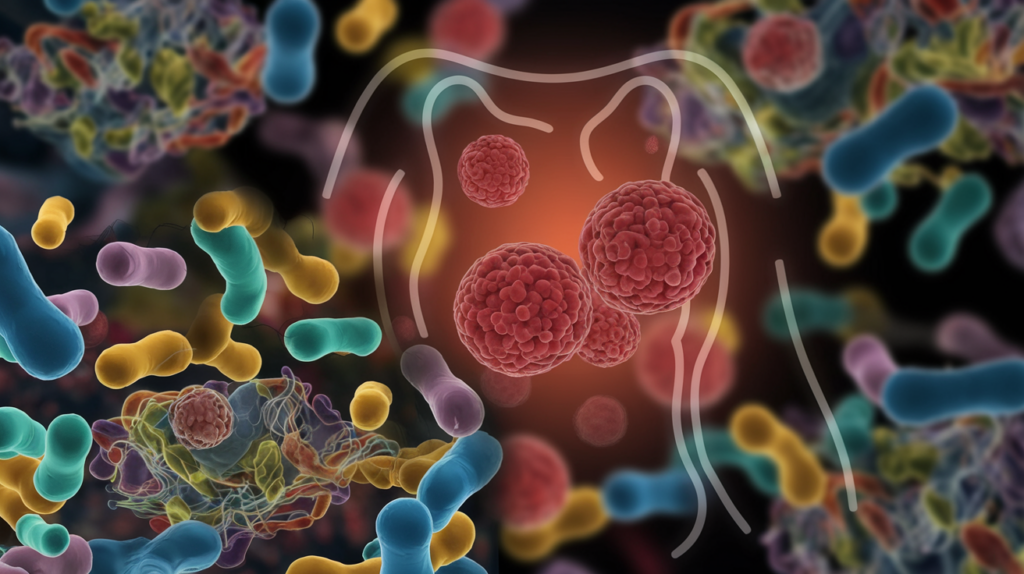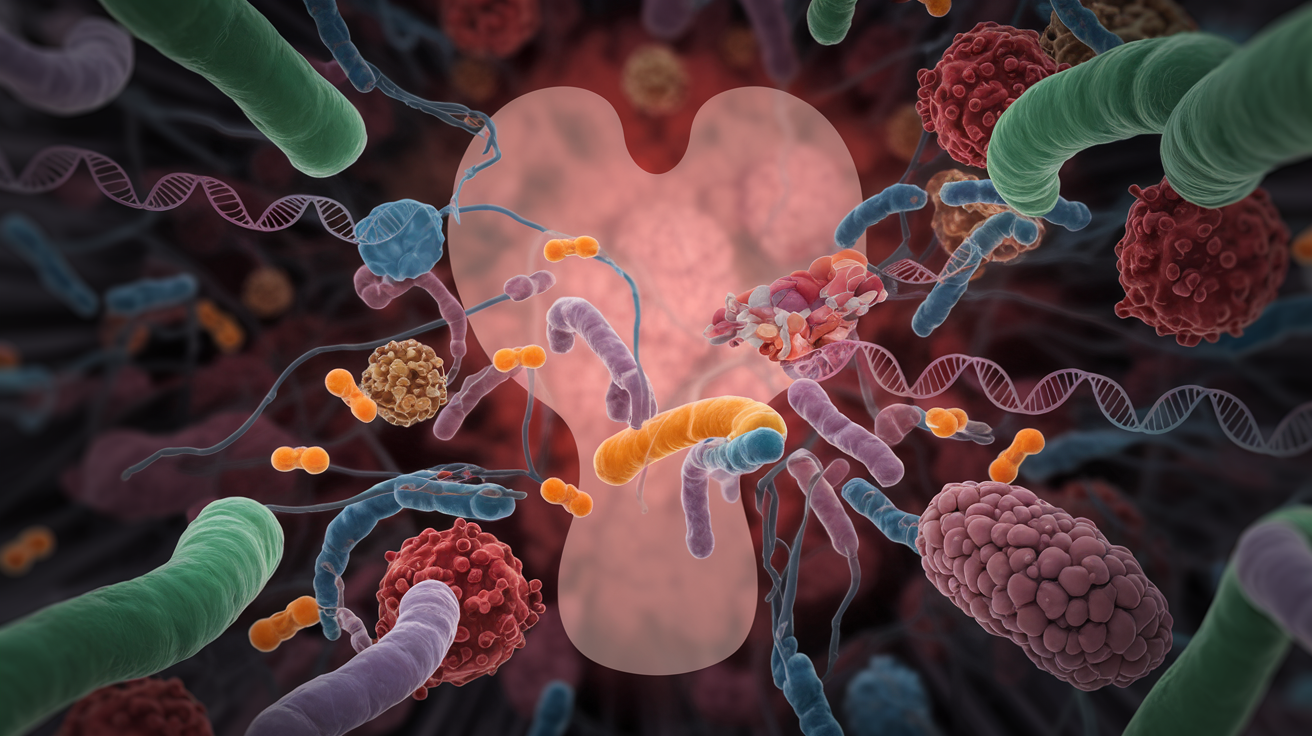Part 2 The Microbiome’s Influence on Breast Cancer Immunity: Unveiling the Gut-Breast Connection
Table of Contents
Gut Bacteria and Immune Cell Production
The intricate relationship between gut bacteria and immune cell production plays a role in breast cancer immunity. Your gut microbiome, home to trillions of microorganisms, is not just responsible for digestion; it is a key player in shaping your immune system’s response to various threats, including cancer.
Research has shown that certain gut bacteria can stimulate the production of specific immune cells that are vital in fighting breast cancer. For instance, some bacteria species can promote the development of T cells and natural killer (NK) cells, which are essential for recognising and eliminating cancer cells.
Here is a breakdown of how gut bacteria influence immune cell production:
- Stimulation of bone marrow: Certain gut bacteria produce short-chain fatty acids (SCFAs) that can stimulate bone marrow to produce more immune cells.
- Regulation of cytokine production: Gut microbes can influence the production of cytokines, which are signalling molecules that help coordinate immune responses.
- Activation of innate immune cells: Some bacteria can activate dendritic cells and macrophages, key players in the innate immune system.
- Modulation of T cell differentiation: Specific bacterial species can influence the differentiation of T cells into various subtypes, including those that are particularly effective against cancer cells.
| Bacterial Species | Immune Cell Affected | Impact on Breast Cancer Immunity |
| Bifidobacterium | T cells | Enhances anti-tumor T cell responses |
| Lactobacillus | NK cells | Increases NK cell activity against breast cancer cells |
| Akkermansia muciniphila | Dendritic cells | Improves antigen presentation and T cell activation |
| Faecalibacterium prausnitzii | Regulatory T cells | Helps maintain immune balance and prevent excessive inflammation |
By understanding these interactions, you can take steps to support a healthy gut microbiome, potentially boosting your immune system’s ability to fight breast cancer.
Microbiome-derived Metabolites and Cancer
Your gut microbiome doesn’t just influence immune cell production; it also produces a variety of metabolites that can directly impact breast cancer development and progression. These microbiome-derived compounds can either promote or inhibit cancer growth, making them a crucial area of study in breast cancer research.
Some key microbiome-derived metabolites and their effects on breast cancer include:
- Short-chain fatty acid (SCFA) production:
- Gut bacteria ferment dietary fibre to produce SCFAs like butyrate, propionate, and acetate.
- These SCFAs have anti-inflammatory and anti-cancer properties.
- SCFAs can influence gene expression in breast tissue, potentially suppressing tumor growth.
- Cadaverine is a bioactive metabolite produced by certain gut bacteria through the decarboxylation of the amino acid lysine. Cadavarine may play a role in modulating breast cancer progression. It has been shown to reduce breast cancer aggressiveness by impacting cell invasion, migration, and stem-like properties. In early-stage breast cancer, a decrease in bacterial cadaverine biosynthesis has been observed, leading to reduced levels of this potentially anti-cancer metabolite. The Scientific Reports study found that early-stage breast cancer patients had reduced abundance of the bacterial CadA and LdcC genes in fecal DNA (responsible for cadaverine production) and lower fecal protein expression of E. coli LdcC compared to healthy women.
- Secondary bile acids: Some gut bacteria can convert primary bile acids into secondary bile acids, which may promote breast cancer growth in certain contexts. Lithocholic acid, a type of secondary bile acid, was shown to inhibit the proliferation and invasion of BC cells through T Cell Receptor Gamma 5 (TGR5). Sodium bile deoxycholate (SBDC) can promote the growth of tumor cells.
- Lipopolysaccharides (LPS): These components of bacterial cell walls can trigger inflammation and potentially contribute to cancer progression.
- Tryptophan metabolites: Certain gut bacteria can produce metabolites from tryptophan that influence immune function and potentially impact cancer growth.
The impact of these metabolites on breast cancer can be complex and multifaceted:
- Direct effects on cancer cells: Some metabolites can directly influence the growth, survival, and metastasis of breast cancer cells.
- Modulation of the tumor microenvironment: Certain metabolites can alter the local environment around tumours, affecting factors like inflammation and blood vessel formation.
- Influence on drug metabolism: Microbiome-derived compounds can interact with cancer drugs, potentially affecting their efficacy or side effects.
- Epigenetic changes: Some metabolites can induce epigenetic modifications in breast tissue, potentially influencing cancer risk or progression.
Understanding these interactions can help you make informed decisions about diet and lifestyle choices that support a healthy gut microbiome and potentially reduce breast cancer risk.
Influence on Inflammatory Responses
Inflammation plays a complex role in breast cancer development and progression. Your gut microbiome has a significant influence on inflammatory responses throughout your body, including in breast tissue. This connection is a critical aspect of the gut-breast axis in breast cancer immunity.
The microbiome can affect inflammatory responses in several ways:
- Production of pro-inflammatory compounds: Some gut bacteria can produce substances that promote inflammation, potentially creating an environment conducive to cancer growth.
- Generation of anti-inflammatory metabolites: Other bacteria produce compounds that help reduce inflammation, potentially inhibiting cancer development.
- Regulation of immune cell function: The microbiome can influence how immune cells respond to inflammatory signals, affecting the overall inflammatory state.
- Modulation of intestinal barrier function: A healthy microbiome helps maintain the integrity of the gut lining, preventing the leak of inflammatory compounds into the bloodstream.
Here is a table summarising some key inflammatory mediators influenced by the gut microbiome and their potential effects on breast cancer:
| Inflammatory Mediator | Source | Effect on Breast Cancer |
| IL-6 | Produced by certain gut bacteria | Can promote breast cancer cell growth and metastasis |
| TNF-α | Stimulated by microbial products | May contribute to tumour progression and drug resistance |
| IL-10 | Induced by beneficial bacteria | Has anti-inflammatory effects, potentially inhibiting cancer growth |
| TGF-β | Influenced by microbial metabolites | Can have both pro- and anti-tumor effects depending on context |
Modulation of Oestrogen Metabolism
Your gut microbiome plays a crucial role in regulating oestrogen levels, which is particularly relevant for hormone-dependent breast cancers. The collection of bacteria and their genes involved in oestrogen metabolism is often referred to as the “oestrobolome.”
Oestrogens are primarily produced in the ovaries, adrenal glands, and adipose tissue. They are metabolised in the liver and excreted into the bile, which delivers them to the intestine.
Here is how your gut microbiome influences oestrogen metabolism:
- Deconjugation of oestrogens: Some gut bacteria possess enzymes that can deconjugate oestrogens, making them more easily reabsorbed into the bloodstream.
- Production of oestrogen-like compounds: Certain bacteria can produce compounds that mimic oestrogen’s effects in the body.
- Regulation of enterohepatic circulation: The microbiome influences the recycling of oestrogens between the liver and the intestines.
- Modification of oestrogen receptors: Some microbial metabolites can affect the expression and function of oestrogen receptors in breast tissue.
- Chronic inflammation is increasingly recognised as a significant factor in the development of various cancers, including breast cancer. A key player in this process is the enzyme cyclooxygenase-2 (COX-2), which catalyzes the production of prostaglandin E2 (PGE2), a compound involved in inflammatory responses. Elevated levels of COX-2 and PGE2 have been observed in breast cancer tissues, suggesting a role in tumour initiation and progression and potentially increasing oestrogen production.
- PGE₂ significantly stimulates the expression and activity of aromatase, the enzyme responsible for converting androgens into estrogens. This effect is particularly notable in adipose stromal cells and fibroblasts within the breast tissue. Elevated aromatase activity leads to increased local oestrogen production, which can promote the growth of oestrogen-dependent breast cancer cells.
The impact of these processes on breast cancer risk and progression can be significant:
- Higher oestrogen levels: An imbalanced microbiome may lead to increased oestrogen reabsorption, potentially promoting the growth of hormone-sensitive breast cancers.
- Altered oestrogen metabolism: Changes in the microbiome can affect how oestrogen is broken down in the body, potentially leading to the production of more or less harmful metabolites.
- Interference with cancer treatments: Some hormone-based breast cancer treatments may be less effective if the microbiome is disrupting normal oestrogen metabolism.
To support healthy oestrogen metabolism and potentially reduce breast cancer risk, consider the following:
- Consume a diet rich in fibre and fermented foods to support a diverse, healthy microbiome.
- Limit exposure to environmental toxins that can disrupt both the microbiome and hormone balance.
- Consider probiotic supplements, but consult with a healthcare provider first, especially if you are undergoing cancer treatment.
By understanding the link between your gut microbiome and oestrogen metabolism, you can take proactive steps to maintain a healthy balance, potentially reducing your risk of hormone-dependent breast cancers.
Progesterone, Gut Microbiome, and Breast Cancer
Progesterone, primarily produced by the ovaries, influences breast tissue development and has complex relationships with cancer risk. Its effects vary depending on whether it’s natural progesterone or synthetic progestins used in hormone therapies.
The gut microbiome affects hormone metabolism through specialised bacterial communities that modify progesterone and oestrogens. This “oestrobolome” influences hormone circulation and availability, indirectly affecting breast tissue.
Progesterone can alter gut permeability and microbial composition, while gut bacteria produce enzymes that affect progesterone circulation throughout the body. This bidirectional relationship creates a feedback loop between hormonal systems and microbial communities.
The immune system serves as another connection point, with both progesterone and gut microbes shaping inflammatory responses that can influence tumor development. Microbial metabolites may directly affect progesterone receptor signaling in breast cells, altering tissue sensitivity to hormones.
These connections suggest potential clinical approaches, including dietary interventions targeting gut microbiome composition to modify breast cancer risk. Research continues to explore specific microbial signatures associated with progesterone metabolism and develop microbiome-targeted interventions for breast cancer prevention and treatment.
Understanding this axis emphasises the importance of viewing the body as an interconnected system where hormones, microbes, and tissues work together to influence breast cancer development.
Now that we have explored the various ways the microbiome impacts breast cancer immunity, it is essential to understand how dysbiosis – an imbalance in the gut microbiome – can increase breast cancer risk. This knowledge will help you appreciate the importance of maintaining a healthy gut ecosystem for breast cancer prevention and treatment.

Gut Microbiome Dysbiosis and Breast Cancer Risk
The “seed and soil hypothesis,” first proposed by Stephen Paget in 1889, is a foundational concept in understanding cancer metastasis. It posits that the spread of cancer cells (the “seed”) to distant organs is not a random process but rather depends on the compatibility of these cells with the microenvironment of the secondary site (the “soil”). For a metastasis to successfully establish, the “seed” must find a “soil” that provides the necessary nutrients, growth factors, and immune evasion mechanisms.
What is the relevance for an article on breast cancer and the microbiome?
The seed and soil hypothesis is highly relevant to an article exploring the relationship between breast cancer and the microbiome in several key ways:
The Microbiome as Part of the “Soil”: The microbiome, encompassing the bacteria, fungi, viruses, and their genetic material present in various tissues (including the gut, breast tissue, and other organs), forms a crucial part of the “soil.” The composition and function of these microbial communities can significantly influence the microenvironment of both the primary tumour and potential metastatic sites.
Local Tumor Microenvironment: The microbiome within or near the breast tumour can directly interact with cancer cells, influencing their growth, invasion, and even their potential to metastasise (the “seed” characteristics). Specific microbial profiles within tumours have been identified and linked to different disease stages and outcomes.
Distant Metastatic Sites: The microbiome at distant organs (e.g., liver, bone, lungs) can shape the pre-metastatic niche, making it more or less hospitable for arriving breast cancer cells. For example, alterations in the gut microbiome can affect systemic inflammation, immune responses, and even hormone levels (like oestrogen), all of which can impact the “soil” in distant organs.
Microbiome Influence on the “Seed”: The microbiome can also indirectly influence the “seed” itself (the breast cancer cells).
Systemic Effects: The gut microbiome, in particular, can produce metabolites that enter the bloodstream and potentially alter the characteristics of breast cancer cells, affecting their aggressiveness and metastatic potential.
Immune Modulation: The microbiome plays a significant role in shaping the host’s immune system. Alterations in the microbiome can lead to chronic inflammation or immune dysregulation, which can either promote or inhibit the development of a more aggressive “seed” capable of successful metastasis.
Explaining Metastatic Patterns: Breast cancer has a predilection for metastasising to specific organs like bone, lung, liver, and brain. The seed and soil hypothesis, when integrated with our understanding of the microbiome, can offer potential explanations for these patterns. Specific microbial profiles in these target organs might create a more favourable “soil” for breast cancer cells with certain characteristics (“seeds”).
Therapeutic Implications: Understanding the interplay between the microbiome and the seed and soil dynamics in breast cancer metastasis opens up potential therapeutic avenues.
Modulating the Microbiome: Strategies like prebiotics, probiotics, faecal microbiota transplantation, and targeted antimicrobial therapies could be used to manipulate the microbiome in both the primary tumor and distant sites to create a less favorable “soil” for metastasis.
Targeting Microbiome-Mediated Effects on Cancer Cells: Identifying specific microbial metabolites or immune responses influenced by the microbiome could lead to new therapies that target the “seed” by disrupting these interactions.
The “seed and soil hypothesis” provides a valuable framework for understanding breast cancer metastasis. Integrating the role of the microbiome into this hypothesis adds a critical layer of complexity and opportunity for research.
Factors Causing Microbial Imbalance
Let us now look into the factors that can disrupt the delicate balance of our gut microbiome, potentially increasing breast cancer risk. Gut microbiome dysbiosis, or an imbalance in the microbial community, can be caused by various factors in our daily lives.
- Diet: Your dietary choices play a role in shaping your gut microbiome. A diet high in processed foods, sugar, and unhealthy fats can negatively impact your gut bacteria. On the other hand, a diet rich in fibre, fruits, vegetables, and fermented foods promotes a diverse and healthy microbiome.
- Antibiotics: Antibiotics can reduce the levels of beneficial bacteria and alter the production of key microbial metabolites, such as SCFAs and lignans involved in oestrogen metabolism. Furthermore, antibiotic-induced dysbiosis has been shown in preclinical models to enhance breast cancer metastasis and affect the response to certain cancer therapies like chemotherapy and immunotherapy, highlighting the importance of a balanced gut microbiome for optimal treatment outcomes. While antibiotics are essential for treating bacterial infections, their overuse or misuse can lead to significant disruptions in your gut microbiome. Antibiotics don’t discriminate between harmful and beneficial bacteria, often wiping out both.
- Lignans are naturally occurring compounds found in various plant-based foods, including flaxseeds, sesame seeds, whole grains, fruits, and vegetables. When consumed, these compounds are metabolised by intestinal bacteria into enterolignans, primarily enterolactone and enterodiol. Enterolactone, in particular, has gained attention for its potential influence on breast cancer risk and progression.The production of enterolactone is dependent upon the activity of gut microbiota. Antibiotic usage can disrupt these microbial communities, leading to decreased serum enterolactone concentrations.
- Stress: Chronic stress can alter the composition of your gut microbiome. When you are stressed, your body produces hormones like cortisol that can affect the growth and diversity of gut bacteria.
- Lack of physical activity: Regular exercise has been shown to promote a healthy and diverse gut microbiome. Sedentary lifestyles may contribute to microbial imbalance.
- Environmental toxins: Exposure to environmental pollutants, pesticides, and other toxins can disrupt your gut microbiome.
Here is a table summarising these factors and their potential impact on the gut microbiome:
| Factor | Impact on Gut Microbiome | Potential Consequence |
| Poor diet | Reduces diversity, promotes harmful bacteria | Increased inflammation, weakened immunity |
| Antibiotic overuse | Wipes out beneficial bacteria | Opportunistic pathogens may thrive |
| Chronic stress | Alters bacterial composition | Reduced microbial diversity |
| Sedentary lifestyle | Decreases microbial diversity | Impaired metabolic function |
| Environmental toxins | Disrupts microbial balance | Increased susceptibility to diseases |
Understanding these factors can help you make informed choices to maintain a healthy gut microbiome and potentially reduce your breast cancer risk.
Specific Bacterial Species Linked to Breast Cancer
As you navigate the complex world of gut microbiome and breast cancer, it is important to understand that certain bacterial species have been specifically linked to breast cancer development. Research has identified both protective and potentially harmful bacteria in relation to breast cancer risk.
Protective bacterial species:
- Lactobacillus: These beneficial bacteria are known for their anti-inflammatory properties and ability to produce short-chain fatty acids (SCFAs). SCFAs play a crucial role in maintaining gut health and supporting the immune system.
- Bifidobacterium: This genus has been associated with improved immune function and may help reduce inflammation in the body.
- Akkermansia muciniphila: This species has been linked to improved metabolic health and may play a role in reducing breast cancer risk.
Potentially harmful bacterial species:
- Escherichia coli: Some strains of E. coli have been found to produce a genotoxin called colibactin, which can damage DNA and potentially contribute to breast cancer development.
- Bacteroides fragilis: Certain strains of this species can produce a toxin that may promote inflammation and contribute to cancer development.
- Fusobacterium nucleatum: This species has been associated with colorectal cancer and may also play a role in breast cancer progression.
It is important to note that the presence or absence of these bacteria alone does not determine your breast cancer risk. The overall balance and diversity of your gut microbiome are crucial factors.
Mechanisms of Microbiome-induced Carcinogenesis
Understanding how the microbiome can influence breast cancer development is essential for developing prevention strategies and potential treatments. Several mechanisms have been identified through which gut microbiome dysbiosis may contribute to breast cancer risk:
- Inflammation: Chronic inflammation is a well-known risk factor for cancer development. An imbalanced gut microbiome can lead to increased inflammation throughout your body, including breast tissue. This persistent inflammation can create an environment conducive to cancer growth.
- Oestrogen metabolism: Your gut microbiome plays a crucial role in regulating oestrogen levels in your body. Some gut bacteria possess an enzyme called β-glucuronidase, which can reactivate oestrogen that has been deactivated by your liver. An overabundance of these bacteria can lead to higher circulating oestrogen levels, potentially increasing breast cancer risk, especially in oestrogen-receptor-positive breast cancers.
- Immune system modulation: Your gut microbiome is intricately linked to your immune system. A healthy microbiome helps maintain a balanced immune response, while dysbiosis can lead to immune dysfunction. This can impair your body’s ability to recognise and eliminate cancer cells in their early stages.
- DNA damage: Certain bacteria, like some strains of E. coli mentioned earlier, can produce genotoxins that directly damage DNA. This genetic damage can potentially lead to mutations that initiate cancer development.
- Altered metabolism: Your gut microbiome influences how your body metabolises nutrients, hormones, and even medications. Dysbiosis can lead to metabolic changes that may create an environment more favourable for cancer growth.
- Barrier function disruption: A healthy gut microbiome helps maintain the integrity of your intestinal barrier. When this barrier is compromised due to dysbiosis, it can lead to increased intestinal permeability or “leaky gut.” This allows harmful substances and bacteria to enter your bloodstream, potentially triggering systemic inflammation and affecting distant organs like the breast.
It is important to remember that these mechanisms are interconnected and can influence each other. For example, increased inflammation can lead to DNA damage, while immune system dysfunction can exacerbate the effects of altered metabolism.
By understanding these mechanisms, you can appreciate the complexity of the gut-breast connection and the importance of maintaining a healthy gut microbiome. This knowledge also opens up potential avenues for intervention and prevention strategies.
As you consider the impact of gut microbiome dysbiosis on breast cancer risk, it is important to recognise that while these factors and mechanisms contribute to increased risk, they do not guarantee the development of breast cancer. Many other factors, including genetics, lifestyle choices, and environmental exposures, also play significant roles in breast cancer development.
In the next section, we will explore how you can harness the power of your microbiome for breast cancer prevention. You will learn about practical steps you can take to promote a healthy gut microbiome and potentially reduce your breast cancer risk.
References will be supplied at the end of part 3.



